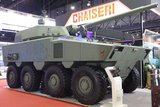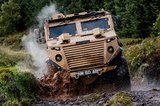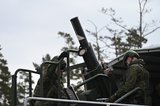Lockheed Martin awarded $756 million for long-range hypersonic weapon
An artist’s notional rendering of the Long Range Hypersonic Weapon. (Image: Lockheed Martin)
Lockheed Martin will provide additional LRHW battery equipment, systems and software engineering support, and logistics solutions to the US Army under a US$756 million contract.
The LRHW weapon system has been designed to launch the common hypersonic All Up Round (AUR) – provided by the US Navy-managed Conventional Prompt Strike (CPS) programme – and will include the army canister, a battery operations centre and transporter erector launchers.
Fiscal 2023 missile procurement, army funds in the amount of $275.3 million were obligated at the time of the award.
Related Articles
US Army advances future long-range fires
How the US Army is getting ready to succeed in contested multidomain scenarios
China turns to US-made AI chips to boost hypersonic weapon performance
In September 2019, the US Army awarded contracts for system supply related to the development of a land-based hypersonic weapon capability. Dynetics Technical Solutions (DTS) was awarded $351.6 million to produce Common-Hypersonic Glide Body (C-HGB) prototypes, while Lockheed Martin was awarded $347 million to lead the LRHW systems integration project.
The 5th Battalion, 3rd Field Artillery Regiment at Joint Base Lewis-McChord, Washington, was designated to operate the first battery of eight LRHW missiles. The battalion, also referred to as a Strategic Long-Range Fires battalion, is part of the Army’s 1st Multi Domain Task Force (MDTF), a unit in the Indo Pacific-oriented I Corps stationed at Joint Base Lewis-McChord.
According to a January 2023 Congressional Budget Office study, US Hypersonic Weapons and Alternatives, purchasing 300 Intermediate-Range Hypersonic Boost Glide Missiles (similar to the LRHW) was estimated to cost $41 million per missile in 2023 dollars.
A January 2023 Center for Strategic and International Studies report, The First Battle of the Next War: Wargaming a Chinese Invasion of Taiwan, noted when discussing hypersonic weapons “their high costs limits inventories, so they lack the volume needed to counter the immense numbers of Chinese air and naval platforms”.
More from Land Warfare
-
![Germany set to order 75 more Leopard 2A8s after 12 months of wins for the platform]()
Germany set to order 75 more Leopard 2A8s after 12 months of wins for the platform
Leopard 2 variants have been introduced in 15 European countries and are in use across 23 nations worldwide, with 301 Leopard 2A8s alone having now been ordered.
-
Chaiseri’s quartet of new vehicles offers fresh capabilities to Asian markets
The Guardian-T 8x8, Hisaar MRAP 4x4, Ridgeback 4x4 and Jackal 4x4 were all on display at Defense & Security 2025, with target markets for the vehicles including Indonesia, Malaysia and the Philippines as well as Thailand.
-
![The British Army’s Land Mobility Programme – all change but no progress?]()
The British Army’s Land Mobility Programme – all change but no progress?
The UK’s Land Mobility Programme, an effort to replace thousands of British Army vehicles, may be about to undergo a radical change in direction.
-
![Supacat and KNDS join forces for British Army vehicle programme]()
Supacat and KNDS join forces for British Army vehicle programme
The Land Mobility Programme is the biggest UK opportunity for the next few decades if it all falls into place. Companies have been filling their dance cards as milestones approach in the hope they are not the mirages of the past.
-
How Patria TREMOS redefines battlefield mobility
The war in Ukraine has made it clear: the battlefield waits for no one. Military operations now take place in fast-paced environments, and speed is not just about the fight itself – it is about the entire ecosystem of warfare.

























